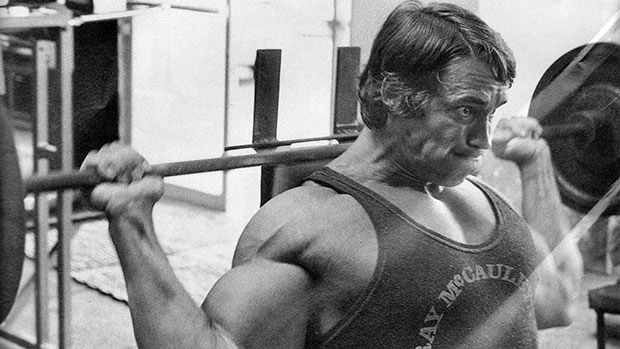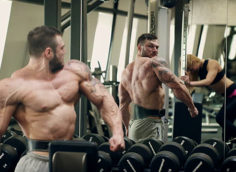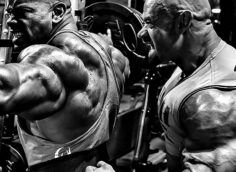Behind the neck presses are one of the best shoulder-building exercises there is, and it used to be a staple among bodybuilders from the 50s up to the early 80s. It's the most effective pressing exercise for overall shoulder development. This is found both in the trenches and in the lab.
Among the three main pressing options – barbell press from the front, behind the neck barbell press, and dumbbell press – the behind the neck press has a significantly greater activation of all three heads of the delt. And there's no doubt that the behind the neck press is superior to the barbell military press (seated or standing). It's not even close.
When comparing the standing versions of behind the neck presses with dumbbell presses, the dumbbell press hits more of the anterior delt, but the anterior delt is usually over-stimulated with all the bench pressing we do. And when comparing the seated versions of the behind the neck press and the dumbbell press, once again, the behind the neck press is the clear winner.
What About Safety?
Someone with a normal posture and no shoulder mobility issues should have no problem doing the behind the neck press safely. There are only two kinds of people who will have problems:
- Those with a pronounced kyphosis (a rounded upper back and hunched shoulders).
- Those with pre-existing shoulder mobility issues.
If you're unable to do the behind the neck press comfortably, that's a sign you should work on shoulder mobility. In fact, the behind the neck press is a good diagnostic tool to see how functional your shoulders are.
It's not the exercise that's the problem. It's the fact that it can highlight pre-existing shoulder issues. If you add it to your training, make sure that you don't lack mobility or have a shoulder injury. Start light until you find your groove.
Who Does Behind the Neck Pressing?
Olympic lifting powerhouse, Dmitry Klokov, for one. He does it in various forms: wide grip, narrow grip, strict, and with a push. Many even call the wide-grip behind the neck press a Klokov press.

Klokov once suffered a serious shoulder injury attempting a 265-270 kg jerk from the racks in training. Afterward he started to emphasize various overhead pressing movements. Now, if a lifter who suffered a severe shoulder injury can do behind the neck presses with over 315 pounds, that's a sign that if you have proper mobility it's a not an inherently dangerous exercise.
T Nation contributor Paul Carter is a monster presser, having done 365 pounds in the strict behind the neck press. Paul has a permanently separated shoulder. Despite that, he can still handle monster weights in the behind the neck press.
Ted Arcidi, one of the first to officially bench press 700 pounds, used the behind the neck press as his main upper body builder. He too was able to handle hefty loads without compromising his shoulders.
Maybe it's time for you to re-think the behind the neck press too.





